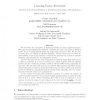1047 search results - page 148 / 210 » Learning the required number of agents for complex tasks |
JALC
2007
13 years 7 months ago
2007
We determine the complexity of learning problems for unary regular languages. We begin by investigating the minimum consistent dfa (resp. nfa) problem which is known not to be app...
ICML
2010
IEEE
13 years 8 months ago
2010
IEEE
Restricted Boltzmann Machines (RBMs) are a type of probability model over the Boolean cube {-1, 1}n that have recently received much attention. We establish the intractability of ...
ISRR
2005
Springer
14 years 1 months ago
2005
Springer
A novel model for dynamic emergence and adaptation of embodied behavior is proposed. A musculo-skeletal system is controlled by a number of chaotic elements, each of which driving...
NIPS
1989
13 years 9 months ago
1989
Cascade-Correlation is a new architecture and supervised learning algorithm for artificial neural networks. Instead of just adjusting the weights in a network of fixed topology,...
PRL
2007
13 years 7 months ago
2007
Recently, boosting has come to be used widely in object-detection applications because of its impressive performance in both speed and accuracy. However, learning weak classifier...

